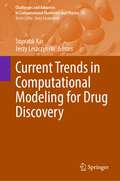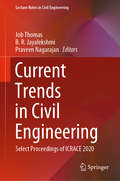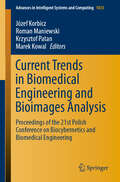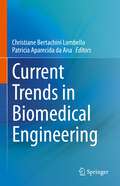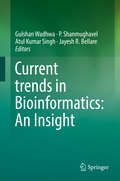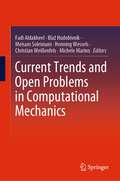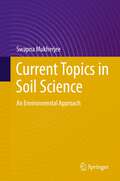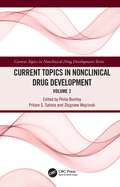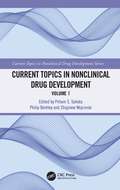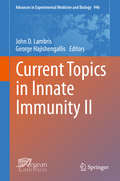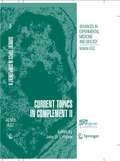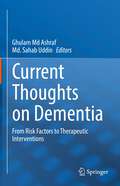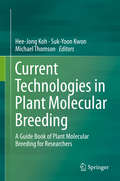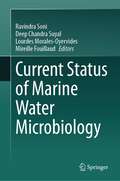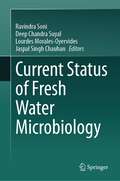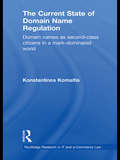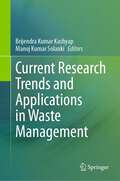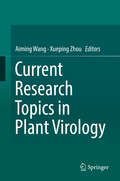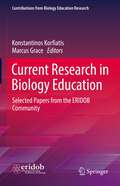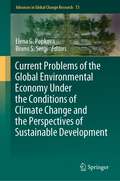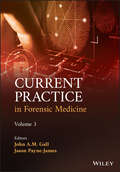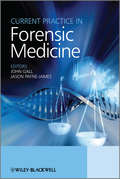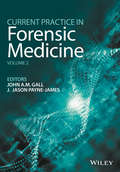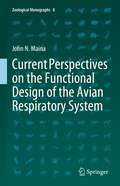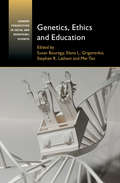- Table View
- List View
Current Trends in Computational Modeling for Drug Discovery (Challenges and Advances in Computational Chemistry and Physics #35)
by Supratik Kar Jerzy LeszczynskiThis contributed volume offers a comprehensive discussion on how to design and discover pharmaceuticals using computational modeling techniques. The different chapters deal with the classical and most advanced techniques, theories, protocols, databases, and tools employed in computer-aided drug design (CADD) covering diverse therapeutic classes. Multiple components of Structure-Based Drug Discovery (SBDD) along with its workflow and associated challenges are presented while potential leads for Alzheimer’s disease (AD), antiviral agents, anti-human immunodeficiency virus (HIV) drugs, and leads for Severe Fever with Thrombocytopenia Syndrome Virus (SFTSV) disease are discussed in detail. Computational toxicological aspects in drug design and discovery, screening adverse effects, and existing or future in silico tools are highlighted, while a novel in silico tool, RASAR, which can be a major technique for small to big datasets when not much experimental data are present, is presented. The book also introduces the reader to the major drug databases covering drug molecules, chemicals, therapeutic targets, metabolomics, and peptides, which are great resources for drug discovery employing drug repurposing, high throughput, and virtual screening. This volume is a great tool for graduates, researchers, academics, and industrial scientists working in the fields of cheminformatics, bioinformatics, computational biology, and chemistry.
Current Trends in Civil Engineering: Select Proceedings of ICRACE 2020 (Lecture Notes in Civil Engineering #104)
by Job Thomas B. R. Jayalekshmi Praveen NagarajanThis book comprises the select proceedings of the International Conference on Recent Advances in Civil Engineering (ICRACE) 2020, held at the Cochin University of Science and Technology, Cochin, Kerala, India. The book focuses on latest research in different areas of civil engineering and lays special emphasis on sustainable construction practices. It is divided into seven major themes: (i) Modern materials and sustainable construction, (ii) Environmental engineering and management, (iii) Geotechnical engineering, (iv) Health, safety and environment, (v) Irrigation, water resources and management, (vi) Structural Engineering, and (vii) Transportation engineering and traffic planning. Given the range of the topics covered, this book can be useful for students, scholars and professionals interested in the different sub-disciplines of civil engineering.
Current Trends in Biomedical Engineering and Bioimages Analysis: Proceedings of the 21st Polish Conference on Biocybernetics and Biomedical Engineering (Advances in Intelligent Systems and Computing #1033)
by Józef Korbicz Roman Maniewski Krzysztof Patan Marek KowalThis book gathers 30 papers presented at the 21st PCBBE, which was hosted by the University of Zielona Góra, Poland, and offered a valuable forum for exchanging ideas and presenting the latest developments in all areas of biomedical engineering. Biocybernetics and biomedical engineering are currently considered one of the most promising ways to improve health care and, consequently, the quality of life. Innovative technical solutions can better meet physicians’ needs and stimulate the development of medical diagnostics and therapy. We are currently witnessing a profound change in the role of medicine, which is becoming ubiquitous in everyday life thanks to technological advances. Further, the development of civilization manifests itself in efforts to unlock the secrets of the human body, and to mimic biological systems in engineering. The biannual Polish Conference on Biocybernetics and Biomedical Engineering (PCBBE) has been held for nearly four decades and has attracted scientists and professionals in the fields of engineering, medicine, physics, and computer science. Gathering the outcomes of this conference, the book introduces the reader to recent developments and achievements in biocybernetics and biomedical engineering.
Current Trends in Biomedical Engineering
by Christiane Bertachini Lombello Patricia Aparecida da AnaThis book brings together the latest updates from various subareas of biomedical engineering, providing readers with a broad overview of the current state of the art and the technological trends to be refined in the coming years with the goal of improving human health. It shows the important advances in each subfield, rehabilitation technology, computational systems applied to health, and medical devices, with practical examples. It includes topics not covered in other books in the area, such as digital health, bioprinting, organs-on-a-chip, the open data paradigm, and electrical impedance tomography. It is a short and easy-to-read book, and provides bibliographic references for the reader to go deeper into their areas of interest. This book is aimed at a very broad group of professionals and students in biomedical engineering and related areas, seeking to contextualize and understand the latest scientific advances in each subfield of biomedical engineering, including neuroengineering, regenerative medicine, additive manufacturing orthosis, postural analysis of Parkinson's patients, modelling and simulation using biomechanical open data, regenerative medicine, advanced drug delivery systems, bioprinting, biophotonic and electrical impedance tomography.
Current trends in Bioinformatics: An Insight
by Gulshan Wadhwa P. Shanmughavel Atul Kumar Singh Jayesh R. BellareThis book highlights the latest breakthrough developments in bioinformatics. It presents a series of timely, in-depth reviews, drug clinical trial studies, biodiversity informatics and thematic issues. In addition, it includes insightful reviews on advances in computational molecular/structural biology, which address areas such as computing in biomedicine and genomics, computational proteomics and systems biology, and metabolic pathway engineering. Innovations in these fields have direct impacts on key issues related to healthcare, medicine, genetic disorders, the development of agricultural products, renewable energy, and environmental protection. Written by respected leaders in the field and covering a wide range of topics involving the integration of biology with computer and information science, the book offers an ideal basis for teaching at the undergraduate and graduate levels. It can also be used for self-instruction by research investigators interested in applying bioinformatics-based analytical methods and information technologists working with academic and industrial laboratories.
Current Trends and Open Problems in Computational Mechanics
by Fadi Aldakheel Blaž Hudobivnik Meisam Soleimani Henning Wessels Christian Weißenfels Michele MarinoThis Festschrift is dedicated to Professor Dr.-Ing. habil. Peter Wriggers on the occasion of his 70th birthday. Thanks to his high dedication to research, over the years Peter Wriggers has built an international network with renowned experts in the field of computational mechanics. This is proven by the large number of contributions from friends and collaborators as well as former PhD students from all over the world. The diversity of Peter Wriggers network is mirrored by the range of topics that are covered by this book. To name only a few, these include contact mechanics, finite & virtual element technologies, micromechanics, multiscale approaches, fracture mechanics, isogeometric analysis, stochastic methods, meshfree and particle methods. Applications of numerical simulation to specific problems, e.g. Biomechanics and Additive Manufacturing is also covered. The volume intends to present an overview of the state of the art and current trends in computational mechanics for academia and industry.
Current Topics in Soil Science: An Environmental Approach
by Swapna MukherjeeSoil is an important but often neglected element of the climate system. It is the second largest carbon store, or ‘sink’, after the oceans. Despite being a fundamental resource that supports all kinds of life on Earth, concerns related to soil are often not included as an important environmental issue. Climate changes put soil under pressure. The increasing concentration of carbon dioxide in our atmosphere may cause the microbes in the soil to work faster to break down organic matter, potentially releasing even more carbon dioxide. The soil moisture content is being constantly affected by rising temperatures and changes in precipitation patterns and future projections show that this may continue. This book presents current environmental issues and their remedies for soil which are mainly based on soil degradation, soil pollution and the effect of climate change on the soil. Adding xenobiotic chemicals or other alterations in the natural soil environment for agricultural, industrial or urban purposes result in a decline in the soil quality due to improper use or poor management, which is a serious environmental problem. The book is divided into five parts - soil science, soil physics, soil chemistry, soil biology and soil environment. The first part “Soil Science” serves as the introduction to the book and discusses some common topics such as soil formation, mineralogy, taxonomy, quality and analytical techniques. The second part “Soil Physics” is mainly concerned with the physical properties and processes of soil and their association with effects on air, water and temperature. Soil Chemistry, the third part, discusses the chemical reactions and processes between inorganic and organic components. The fourth part “Soil Biology” explains the biological properties and processes of the soil, with special concern to microbial diversity and its effect on the ecology. Lastly, the fifth part “Soil Environment” discusses the current environmental problems such as climate change and soil pollution, including processes to mitigate these issues through carbon sequestration, nutrient management and land management.
Current Topics in Nonclinical Drug Development: Volume 2 (Current Topics in Nonclinical Drug Development Series)
by Philip Bentley Pritam S. Sahota Zbigniew WojcinskiThe second volume in the CURRENT TOPICS IN NONCLINICAL DRUG DEVELOPMENT SERIES explores the critical issues and current topics in nonclinical drug development. This second volume covers individual topics and strategies in drug development from compound characterization to drug registration. Written by a variety of experts in the field, recent and rapid advances in technologies and associated changes in regulatory guidance are discussed. Select topics include: Evolution of Artificial Intelligence (AI) technologies and the impact on toxicologic pathology. Current approaches to carcinogenicity testing. Predicting drug-drug interactions. Current understanding of idiosyncratic drug reaction. Assessing cardiovascular risks beyond QT interval. Use of 3D cell cultures in toxicology and ADME. Development of small molecule-antibody complexes. Differentiating adverse from non-adverse findings in nonclinical studies. Current Topics in Nonclinical Drug Development: Volume 2 will aid toxicologists, toxicologic pathologists, consultants, regulators, study directors, and nonclinical scientists dealing with day-to-day issues encountered in drug development and assist in formulating strategies for resolution of these issues. In addition, the book will be a valuable reference for academicians and graduate students pursuing research related to nonclinical drug development.
Current Topics in Nonclinical Drug Development: Volume 1 (Current Topics in Nonclinical Drug Development Series)
by Pritam S. Sahota Philip Bentley Zbigniew WojcinskiThe inaugural volume in the Current Topics in Nonclinical Drug Development Series explores the critical issues and current topics in nonclinical drug development. This first volume covers individual topics and strategies in drug development from compound characterization to drug registration. Written by a variety of experts in the field, recent and rapid advances in technologies and associated changes in regulatory guidance are discussed. Additional features include: Deals with day-to-day issues in study design, evaluation of findings, and presentation of data. Explains new approaches in the development of medical devices. Includes dedicated chapters on the use of bioinformatics in drug development. Addresses strategies for photosafety testing of drugs. Current Topics in Nonclinical Drug Development, Volume I will aid toxicologists, toxicologic pathologists, consultants, regulators, Study Directors, and nonclinical scientists dealing with day-to-day issues in study design, evaluation of findings, and presentation of data. In addition, the book will be a valuable reference for academicians and graduate students pursuing research related to nonclinical drug development.
Current Topics in Innate Immunity II (Advances in Experimental Medicine and Biology #946)
by John D. Lambris George HajishengallisMounting evidence in the past decade indicates that innate immunity mediates functions above and beyond first-line defense against infection. It is now appreciated that innate immune mechanisms are critically involved in the development of adaptive immunity and, moreover, the regulation of diverse physiological and homeostatic processes. The latter explains why deregulation of innate immunity may lead to pathological disorders that are not necessarily or directly related to host defense. This Volume compiles the latest advances in this rapidly evolving field as presented by eminent scientists at the 7th International Aegean Conference on Innate Immunity in Rhodes, Greece. It includes topics related to the biology and function of Toll-like and other pattern-recognition receptors, complement and its crosstalk with other physiological systems, inflammatory mechanisms and diseases, natural killer cells, and the cooperative interplay between innate and adaptive immune cells. This book is an excellent source of information for researchers and clinicians with interests in immunology, host-microbe interactions, and infectious and inflammatory diseases.
Current Topics in Complement II (Advances in Experimental Medicine and Biology #632)
by John D. LambrisComplement has long been regarded as a pivotal effector arm of the innate immune response, eliciting important immunoregulatory functions in the context of inflammation and also serving as a vital link between the innate and adaptive immune response. In the post-genomic era, our knowledge of the innate immune system is enriched by findings that point to novel functions that do not strictly correlate with immunological defense and surveillance, immune modulation or Inflammation. Several studies indicate that complement proteins exert functions that are either more complex than previously thought, or go well beyond the innate immune character of the system. The advent of high-throughput platforms for genome and proteome-wide profiling, together with the enormous amount of raw genetic information that has accumulated in the databases, have stirred new expectations in biomedical research. They have led complementologists to revisit established biological systems, such as the complement system, from a global and integrative perspective. Complement research is now faced with the challenge of trying to integrate isolated biochemical pathways into complex gene and protein regulatory circuits. In this respect, scientists from around the world convened at the Fourth Aegean Conferences Workshop on Complement Associated Diseases, Animal Models, and Therapeutics (June 10-15, 2007), to discuss recent advances in this fast evolving field. This volume represents a collection of topics on the "novel" functions of complement, patho-physiology, protein structures, design of complement inhibitors, and complement assays discussed during the conference.
Current Thoughts on Dementia: From Risk Factors to Therapeutic Interventions
by Ghulam Md Ashraf Md. Sahab UddinThis informative book discusses the latest research on the risk factors and therapeutics in dementia. WHO calls dementia a public health priority. Dementia manifests as a group of symptoms associated with decline in memory or other thinking skills and is severe enough to reduce a person's ability to perform everyday activities. It occurs frequently among elderly people, but it is not necessarily part of the normal aging process. The book has been divided into two broad sections. The first section reviews the risk factors involved in developing dementia, including various medical conditions, lifestyle choices, as well as genetics. The latter section describes various therapeutic interventions in dementia. Although there is no known cure for dementia, this book underlines the current treatment strategies that could momentarily reduce the symptoms and improve the quality of life of the patients. This book highlights the global effort to find better ways to halt the progression of dementia and develop novel therapeutic strategies. The book would be an interesting read for advanced graduate students and researchers working in the field of neuroscience, genetics, and medicine. It will generate good interest to neurologists, psychiatrists, geriatricians, cardiologists, internal medicine practitioners, epidemiologist, and public health workers.
Current Technologies in Plant Molecular Breeding: A Guide Book of Plant Molecular Breeding for Researchers
by Hee-Jong Koh Suk-Yoon Kwon Michael ThomsonRecent progress in biotechnology and genomics has expanded the plant breeders' horizon providing a molecular platform on the traditional plant breeding, which is now known as 'plant molecular breeding'. Although diverse technologies for molecular breeding have been developed and applied individually for plant genetic improvement, common use in routine breeding programs seems to be limited probably due to the complexity and incomplete understanding of the technologies. This book is intended to provide a guide for researchers or graduate students involved in plant molecular breeding by describing principles and application of recently developed technologies with actual case studies for practical use. The nine topics covered in this book include the basics on genetic analysis of agronomic traits, methods of detecting QTLs, the application of molecular markers, genomics-assisted breeding including epigenomic issues, and genome-wide association studies. Identification methods of mutagenized plants, actual case studies for the isolation and functional studies of genes, the basics of gene transfer in major crops and the procedures for commercialization of GM crops are also described. This book would be a valuable reference for plant molecular breeders and a cornerstone for the development of new technologies in plant molecular breeding for the future.
Current Status of Marine Water Microbiology
by Ravindra Soni Deep Chandra Suyal Lourdes Morales-Oyervides Mireille FouillaudThis contributed volume focuses on the latest innovations in the field of marine microbiology. Marine ecosystems are dynamic natural resources and home to very primitive life forms. They include open sea, deep sea, coastal marine ecosystem mudflats, seagrass meadows, mangroves, and rocky intertidal systems. This book deals with the various aspects of marine microbiology including diverse habitats, associated microorganisms, their adaptations, ecological interactions, biogeochemical cycling, and industrial applications. It also discusses the issue of pollution in oceans and put forward available strategies for its eco-friendly solution. In recent years, extensive research, advanced methodologies, and high-throughput instrumentation have resulted in voluminous data and information that require proper compilation and worldwide sharing. From this perspective, the book is a perfect documentation of primary and secondary data-based information on the latest research findings, case studies, experiences, and innovations in the field of marine microbiology. The book is of great use to students, researchers and professionals studying marine sciences.
Current Status of Fresh Water Microbiology
by Ravindra Soni Deep Chandra Suyal Lourdes Morales-Oyervides Jaspal Singh ChauhanThis contributed volume deals with the various aspects of freshwater microbiology including diverse habitats, associated microorganisms, their ecological interactions, and industrial applications. Freshwater ecosystems are dynamic natural resources, providing sources of potable water, food, animal habitats, and recreation. Perspectives of microbial dynamics in freshwater bodies, covered in this title, provide a comprehensive and systematic analysis of microbial ecology in these ecosystems. These microbes are at the hub of biogeochemical cycles (carbon, nitrogen, phosphorus, potassium, and other elements). Moreover, they are an integral part of the aquatic food web and control the quality of freshwater bodies. Chapters in this title also discuss the issue of pollution in freshwater bodies and put forward available strategies for eco-friendly solutions. The book is a perfect documentation of primary and secondary data-based information on the latest research findings, case studies, experiences, and innovations in the field of freshwater microbiology. The book is of great use to students, researchers, and professionals studying aquatic sciences.
The Current State of Domain Name Regulation: Domain Names as Second Class Citizens in a Mark-Dominated World (Routledge Research in Information Technology and E-Commerce Law)
by Konstantinos KomaitisIn this book Konstantinos Komaitis identifies a tripartite problem – intellectual, institutional and ethical – inherent in the domain name regulation culture. Using the theory of property, Komaitis discusses domain names as sui generis ‘e-property’ rights and analyses the experience of the past ten years, through the Uniform Domain Name Dispute Resolution Policy (UDRP) and the Anticybersquatting Consumer Protection Act (ACPA). The institutional deficit he identifies, generates a further discussion on the ethical dimensions in the regulation of domain names and prompts Komaitis to suggest the creation of an environment based on justice. The relationship between trademarks and domain names has always been contentious and the existing institutions of the UDRP and ACPA have not assisted in alleviating the tension between the two identifiers. Over the past ten years, the trademark community has been systematic in encouraging and promoting a culture that indiscriminately considers domain names as secondclass citizens, suggesting that trademark rights should have priority over the registration in the domain name space. Komaitis disputes this assertion and brings to light the injustices and the trademark-oriented nature of the UDRP and ACPA. He queries what the appropriate legal source to protect registrants when not seeking to promote trademark interests is. He also delineates a legal hypothesis on their nature as well as the steps of their institutionalisation process that we need to reverse, seeking to create a just framework for the regulation of domain names. Finally he explores how the current policies contribute to the philosophy of domain names as second-class citizens. With these questions in mind, Komaitis suggests some recommendations concerning the reconfiguration of the regulation of domain names.
Current Research Trends and Applications in Waste Management
by Brijendra Kumar Kashyap Manoj Kumar SolankiThis book covers latest information on organic and inorganic waste management, and how the waste can be utilized as an energy source. An increasing world population and climate change rate hint that environmental health needs a sustainable waste recycling system worldwide. Management of wastes material plays a substantial role in the environment and climate regulation. Chapters contain modern tools and techniques for managing inorganic, biomedical, municipality, and food waste. The title covers the role of contemporary microbiology and biotechnological tools in waste management and how these microbial agents can enhance waste degradation and bioenergy production. The book covers interesting topics such as bio-ethanol production from agro-waste, microbial fuel cells, biogas production from animal waste, nanotechnology in waste recycling, etc. The primary audiences are researchers, scientists, students, and policymakers interlinked with waste management and applied microbial sectors.
Current Research Topics in Plant Virology
by Aiming Wang Xueping ZhouTopics covered in this book include RNA silencing and its suppression in plant virus infection, virus replication mechanisms, the association of cellular membranes with virus replication and movement, plant genetic resistance to viruses, viral cell-to-cell spread, long distance movement in plants, virus induced ER stress, virus diversity and evolution, virus-vector interactions, cross protection, geminiviruses, negative strand RNA viruses, viroids, and the diagnosis of plant viral diseases using next generation sequencing. This book was anticipated to help plant pathologists, scholars, professors, teachers and advanced students in the field with a comprehensive state-of-the-art knowledge of the subject.
Current Research in Biology Education: Selected Papers from the ERIDOB Community (Contributions from Biology Education Research)
by Konstantinos Korfiatis Marcus GraceThis book is a collection of full papers based on the peer-reviewed submissions accepted for the ERIDOB 2020 conference (which was cancelled due to COVID-19). ERIDOB brings together researchers in Biology Education from around the world to share and discuss their research work and results. It is the only major international conference on biology education research, and all the papers therefore are written by international researchers from across Europe (and beyond), which present the findings from a range of contemporary biology education research projects. They are all entirely new papers describing new research in the field. The papers are peer-reviewed by experienced international researchers selected by the ERIDOB Academic Committee. The papers reflect the ERIDOB conference strands by covering topics on: Socioscientific issues, Nature of Science and scientific thinkingTeaching and learning in biologyPerceptions of biology and biology educationTextbook analysisOutdoor and environmental education By providing a collection of new research findings from many countries, this book is a great resource for researchers and practitioners such as school, college and university biology teachers' around the world. It is useful for training biology teachers and therefore valuable to teacher training institutions.
Current Problems of the Global Environmental Economy Under the Conditions of Climate Change and the Perspectives of Sustainable Development (Advances in Global Change Research #73)
by Elena G. Popkova Bruno S. SergiThis book presents a systemic view of the global environmental economy under the conditions of climate change from the positions of Sustainable Development Goals. The purpose of the book is to study the current problems of the global environmental economy under the conditions of climate change and to determine the prospects of its sustainable development (systemic support for the SDGs). This goal predetermines the logic and structure of the book, which is comprised of five parts.Part I presents the authors’ novel view of the global environmental economy under the conditions of climate change from the positions of the SDGs. It reflects the contradiction and describes the path of preserving economic growth during the implementation of SDG 13. The COVID-19 pandemic and economic crisis are considered as the result of the reduction of biodiversity under the conditions of climate change from the positions of SDG 3. Responsible innovations, eco-friendly products, and green trade are presented as trends of the environmental economy under the conditions of climate change to support SDG 12. Green jobs are analyzed in the environmental economy under the conditions of climate change during the implementation of SDG 8. The significance of social inclusivity and reduction of the inequality of the environmental economy under the conditions of climate change to support SDG 10 is noted.Part II elaborates on the sectoral specifics of the influence of climate change on the environmental economy: energetics, finance, industry, state management, and agriculture. Part III presents and discusses the international experience of development of the environmental economy under the conditions of climate change given the specifics of developed and developing countries and based on the case experience of Central Asia, the EAEU, and Russia.In Part IV, technological transition (Fourth Industrial Revolution) is offered as a perspective response of the global economic policy to climate change. Scenarios of the fight against climate change in the Decade of Action depending on the scale of the technological transition are described: digital economy vs Industry 4.0 and Society 5.0. The perspectives of the technological transition at the level of companies (creation of cyber-physical systems of Industry 4.0; green digital innovations and smart ESG finance) and regions (smart region as a socio-economic environment with large adaptability to climate change) are described.
Current Practice in Forensic Medicine, Volume 3
by John A.M. Gall J. Jason Payne-JamesCURRENT PRACTICE in Forensic Medicine Presents a unique overview and critical commentary on the latest developments in forensic medical practice worldwide The field of forensic medicine continues to evolve worldwide. In recent years, the amount of research has increased and new areas of forensic specialization have developed. Forensic practitioners need to keep pace with a range of international advances from innovative technologies to new or revised laws and regulations to emerging issues of controversy. Current Practice in Forensic Medicine, Volume 3 provides an in-depth examination of key areas of the field. This timely and comprehensive resource addresses consent for forensic procedures, imaging for soft tissue injuries, working with victims of torture, non-accidental injury in the elderly, medical and toxicological aspects of chemical warfare, non-fatal strangulation, abusive head trauma in young children, and more. Each chapter contains a general overview of the area under discussion, references to published literature, and detailed discussion of significant changes and key points. Offers new insights into false allegations of sexual assault, coercive control and the homicide timeline in partner abuse cases, and the needs of elderly persons in detention Provides non-country specific information to guide international forensic medicine practitioners and healthcare professionals Contains detailed yet concise chapters written by authors with particular expertise in the subject covered Addresses the clinical and pathological aspects of forensic medicine and relevant areas in toxicology, forensic psychiatry and psychology, and forensic biology Covers riot control weapons, chemical warfare, non-fatal strangulation, DNA in crime detection, and many other essential topics Includes up-to-date information on the new Medical Examiner system in England and Wales Supported by the most recent evidence-based research, Current Practice in Forensic Medicine, Volume 3 is a must-have for all those involved in various aspects of forensic medicine including doctors, dentists, forensic scientists, lawyers, law enforcement professionals, and forensic practitioners.
Current Practice in Forensic Medicine
by Jason Payne-James John GallAlthough forensic medicine has been in existence for centuries in one guise or another, it is only with the recent growth in international research that it has begun to be acknowledged as a specific discipline in its own right. Many areas of progress are being made and this text aims to provide a unique, in-depth and critical update on selected topics that are of direct relevance to those practicing in the field including lawyers, police, medical and dental practitioners, forensic scientists and postgraduate/undergraduate medical students and undergraduate law students preparing for forensic medicine examinations.This volume is designed to cover the wider aspects of forensic medicine, including the law, science, medicine (forensic pathology, clinical forensic medicine and forensic psychiatry) and dentistry. Topics covered include subjects of debate and/or uncertainty in areas where significant advances have been made and in those of current relevance to the forensic profession, Chapters provide a variety of approaches to the areas under discussion with reviews of current knowledge, information on significant changes and pointers to the future that the reader should be aware of.Features:An authoritative review, for forensic medicine practitioners throughout the world, from leading international experts in the field.Provides critical commentary and updates on current practice.Topics include: a guide to the presentation of forensic medical evidence, bioterrorism, the paediatric hymen, assessment and interpretation of bone trauma in children, adult sexual assault, genital photography, forensic photography, common errors in injury interpretation, self-inflicted injuries and associated psychological profiles, bite marks and the role of the pathologist in aviation disasters.Includes a wealth of four colour figures to illustrate key points discussed within the text.
Current Practice in Forensic Medicine
by Jason Payne-James John A. GallForensic medicine is a broad and evolving field with areas of rapid progress embracing both clinical and pathological aspects of practice, in which there may be considerable overlap. This is the second volume in a series that provides a unique, in-depth and critical update on selected topics of direct relevance to those practising in the field of clinical forensic medicine and related areas including lawyers, police, medical practitioners, forensic scientists, and students. The chapters endeavour to maintain a relevance to an international, multi-professional audience andinclude chapters on: DNA decontamination, The toxicity of novel psychoactive substances, The relevance of gastric contents in the timing of death, The effects of controlled energy devices, The main risk factors for driving impairment, The risk factors for harm to health of detainees in short-term custody, Autoerotic deaths, Child maltreatment and neglect, and The investigation of potential non-accidental head injury in children. Also included are chapters on excited delirium syndrome, automatism and personality disorders. Two topics not generally covered in standard clinical forensic medical textbooks include a forensic anthropological approach to body recovery in potential crimes against humanity and risk management and security issues for the forensic practitioner investigating potential crimes against humanity in a foreign country.
Current Perspectives on the Functional Design of the Avian Respiratory System (Zoological Monographs #8)
by John N. MainaBirds have and continue to fascinate scientists and the general public. While the avian respiratory system has unremittingly been investigated for nearly five centuries, important aspects on its biology remain cryptic and controversial. In this book, resolving some of the contentious issues, developmental-, structural- and functional aspects of the avian lung-air sac system are particularized: it endeavors to answer following fundamental questions on the biology of birds: how, when and why did birds become what they are? Flight is a unique form of locomotion. It considerably shaped the form and the essence of birds as animals. An exceptionally efficient respiratory system capacitated birds to procure the exceptionally large quantities of oxygen needed for powered (active) flight. Among the extant air-breathing vertebrates, comprising ~11,000 species, birds are the most species-rich-, numerically abundant- and extensively distributed animal taxon. After realizing volancy, they easily overcame geographical obstacles and extensively dispersed into various ecological niches where they underwent remarkable adaptive radiation. While the external morphology of birds is inconceivably uniform for such a considerably speciose taxon, contingent on among other attributes, lifestyle, habitat and phylogenetic level of development have foremost determined the novelties that are displayed by diverse species of birds.Here, critical synthesizes of the most recent findings with the historical ones, evolution and behavior and development, structure and function of the exceptionally elaborate respiratory system of birds are detailed. The prominence of modern birds as a taxon in the Animal Kingdom is underscored. The book should appeal to researchers who are interested in evolutionary processes and how adaptive specializations correlate with biological physiognomies and exigencies, comparative biologists who focus on how various animals have solved respiratory pressures, people who study respiration in birds and other animals and ornithologists who love and enjoy birds for what they are – profoundly interesting animals.
Current Perspectives in Social and Behavioral Sciences: Genetics, Ethics, and Education (Current Perspectives in Social and Behavioral Sciences)
by Latham Stephen R. Susan Bouregy Grigorenko Elena L. Mei TanAdvances in human genetics and genomics are beginning to move outside the traditional realm of medicine and into the classroom. How will educational officials react when asked to incorporate personalized genomic information into the educational program? This volume bridges the divide between science, education and ethics around the emergent integration of genomics and education. By pairing comprehensive analysis of the issues with primers on the underlying science, the authors put all relevant parties on a level field to facilitate thorough consideration and educated discussion regarding how to move forward in this new era, as well as how best to support the future of education and the future of all students. The volume is unique in bringing together not only scholarly experts but also parents and laypersons. In doing so, it gives voice and understanding to a broad spectrum of disciplines that have a stake in the future of education.
